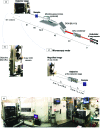Visualization of protein crystals by high-energy phase-contrast X-ray imaging
- PMID: 31692469
- PMCID: PMC6834075
- DOI: 10.1107/S2059798319011379
Visualization of protein crystals by high-energy phase-contrast X-ray imaging
Abstract
For the extraction of the best possible X-ray diffraction data from macromolecular crystals, accurate positioning of the crystals with respect to the X-ray beam is crucial. In addition, information about the shape and internal defects of crystals allows the optimization of data-collection strategies. Here, it is demonstrated that the X-ray beam available on the macromolecular crystallography beamline P14 at the high-brilliance synchrotron-radiation source PETRA III at DESY, Hamburg, Germany can be used for high-energy phase-contrast microtomography of protein crystals mounted in an optically opaque lipidic cubic phase matrix. Three-dimensional tomograms have been obtained at X-ray doses that are substantially smaller and on time scales that are substantially shorter than those used for diffraction-scanning approaches that display protein crystals at micrometre resolution. Adding a compound refractive lens as an objective to the imaging setup, two-dimensional imaging at sub-micrometre resolution has been achieved. All experiments were performed on a standard macromolecular crystallography beamline and are compatible with standard diffraction data-collection workflows and apparatus. Phase-contrast X-ray imaging of macromolecular crystals could find wide application at existing and upcoming low-emittance synchrotron-radiation sources.
Keywords: X-ray refractive lenses; X-ray tomography; lipidic cubic phase; phase-contrast X-ray imaging.
open access.
Figures





References
-
- Als-Nielsen, J. & McMorrow, D. (2011). Elements of Modern X-ray Physics, 2nd ed. Chichester: John Wiley & Sons.
-
- Arhatari, B. D., Peele, A. G., Hannah, K., Kappen, P., Nugent, K. A., Williams, G. J., Yin, G. C., Chen, Y. M., Chen, J. H. & Song, Y. F. (2009). Ultramicroscopy, 109, 280–286. - PubMed
MeSH terms
Substances
Grants and funding
LinkOut - more resources
Full Text Sources
Other Literature Sources
Research Materials

